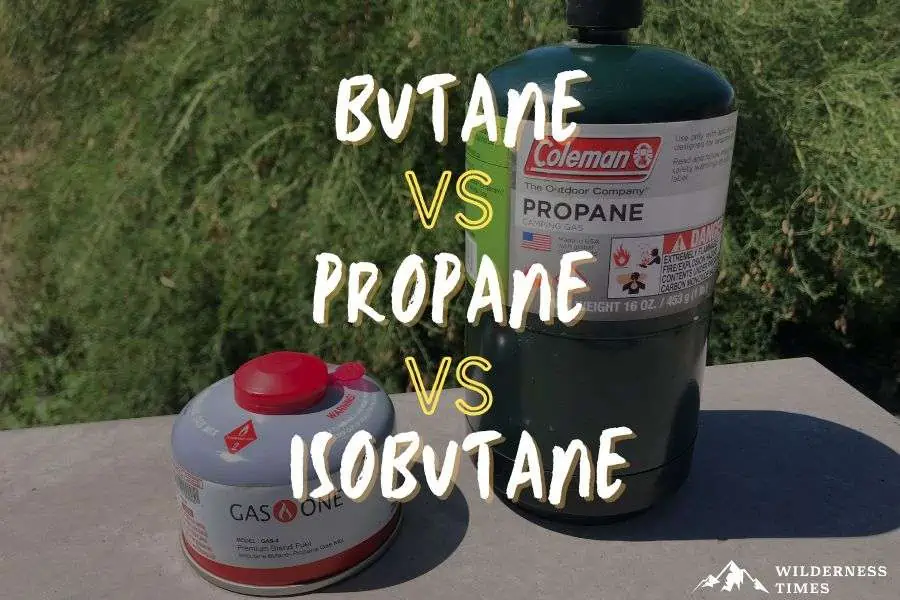Buying new cooking equipment for camping?
You should start with the camping stove, right? Wrong.
First, you’ll want to choose the type of fuel that will power that stove.
The most popular choices among campers are butane, propane and isobutane. But which one is the best?
Well, there’s no easy answer to this question, as there are multiple factors involved.
The first step toward finding the answer is knowing the difference between the three.
That’s why we’re here today. In this article, we’ll talk about each of these fuel types, as well as how they compare.
Without further ado, I present to you the butane vs propane vs isobutane showdown.
Also Read: Types of Camping Stoves (Pros/Cons of Each Stove Type)
Butane vs Propane vs Isobutane
There are several types of camping stove fuels available. But the ones used most commonly are liquified petroleum gases. These include:
- Propane
- Butane
- Isobutane
- White gas
What makes the first three different from white gas is the fact that the latter is kept in liquid form.
At the first glance, propane, butane and isobutane all appear to be pretty similar.
But they’re actually quite different. Let’s talk about each of them in particular.
Butane
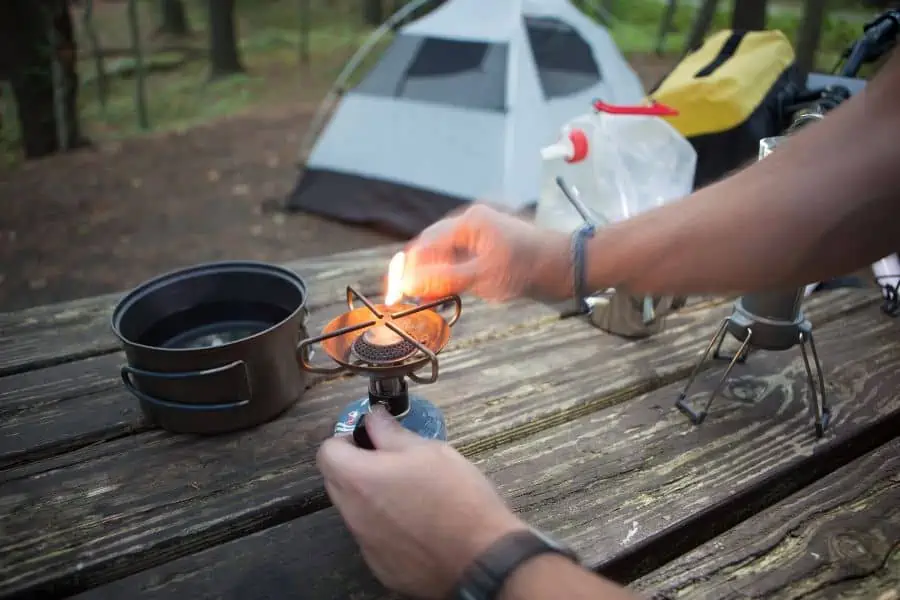
Butane is a colorless, odorless and easily liquefied gas. This makes it great for a variety of purposes, including heating fuel.
And as such, it’s been a popular choice among campers for a long time now.
Butane is extremely flammable, which means it burns very efficiently – as long as the temperature is well above the freezing point.
It lights up practically instantly, so there’s no waiting before you can start cooking.
What’s more, butane is pretty simple to use. Just attach the canister to the stove, and that’s it!
Not just that, but it’s also readily available at most big box stores at an affordable price.
And while it’s not refillable, it’s sold in small canisters (between 4 and 16 ounces) made of aluminum, which is a very light material. For that reason, butane fuel is a great option even when storage space is very limited.
And while it’s true that you shouldn’t inhale butane directly, there’s practically no risk of toxicity is you use it properly.
Plus, since it burns cleanly, butane is not contributing to global warming and environmental pollution.
However, the main problem with using butane lies in the fact that it doesn’t perform well at cooler temperatures. Its flash point is 30.2° Fahrenheit, which is just below freezing. What this means is you won’t be able to cook on it once the outside temperature reaches this point.
But if you’re camping during hotter months, butane fuel is a great choice for you.
Especially on shorter hiking trips, considering how compact and portable its canister is.
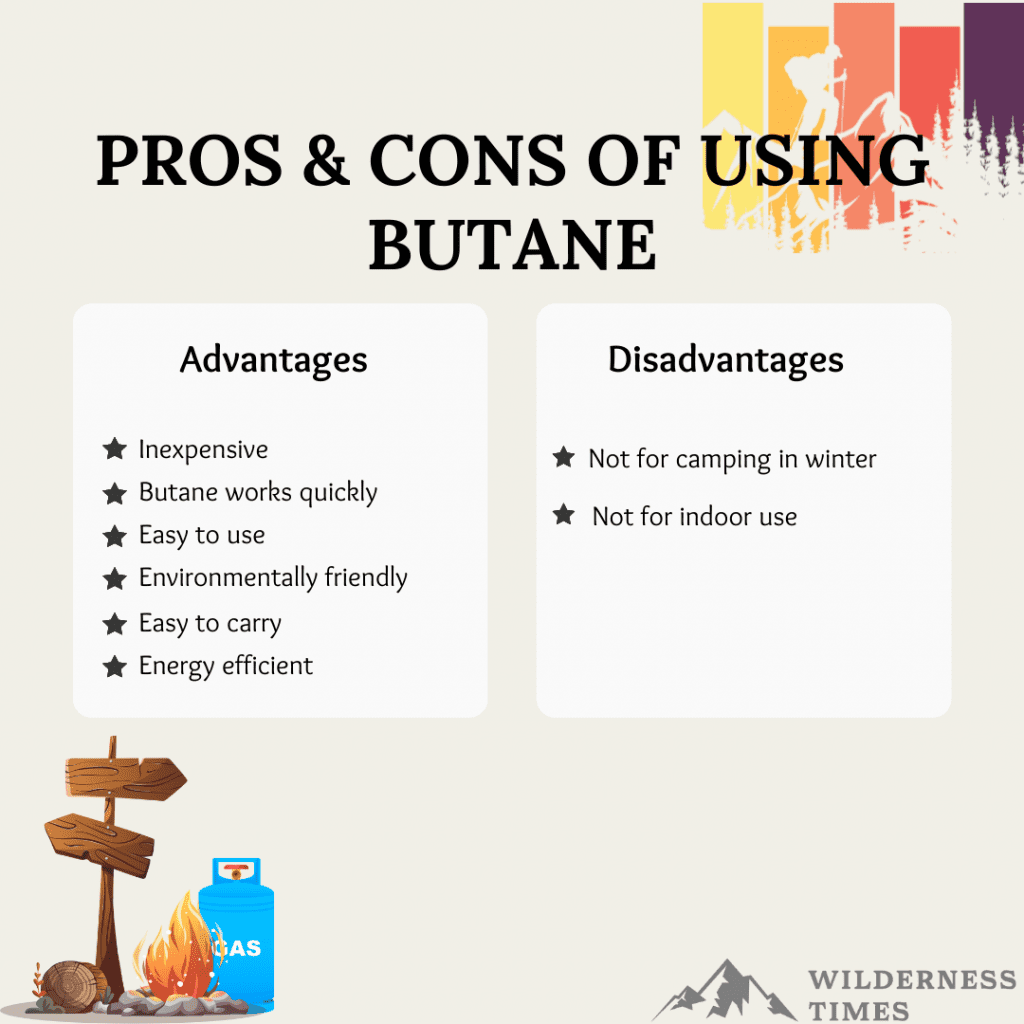
Advantages of Using Butane
- Inexpensive
- Butane works quickly
- Easy to use
- Less toxic and environmentally friendly
- Easy to carry
- Energy efficient
Disadvantages of Using Butane
- Not for camping in winter
- Not for indoor use
- Canisters aren’t refillable
How to Use a Butane Stove?
Using a butane stove is actually pretty simple. Here’s what you need to do:
- Before you start doing anything, make sure that the stove dial is set to the “off” position. That way, there’s no possibility of accidents while setting it up.
- Open the compartment where the butane canister should sit.
- Place down the canister, with the arrow on it pointing towards the dial.
- Line up the latch stove with the divet on the canister.
- Close the compartment door and press the lock lever down.
- Turn the ignite dial clockwise until you hear a click sound, after which the flames will appear.
- After the fire starts burning, you can adjust the amount of gas flow by turning the knob left or right.
- Once you’re done cooking, turn off the stove by switching the knob all the way to “OFF.”
- Remove the canister from the stove, then put them aside, away from sunlight.
Propane
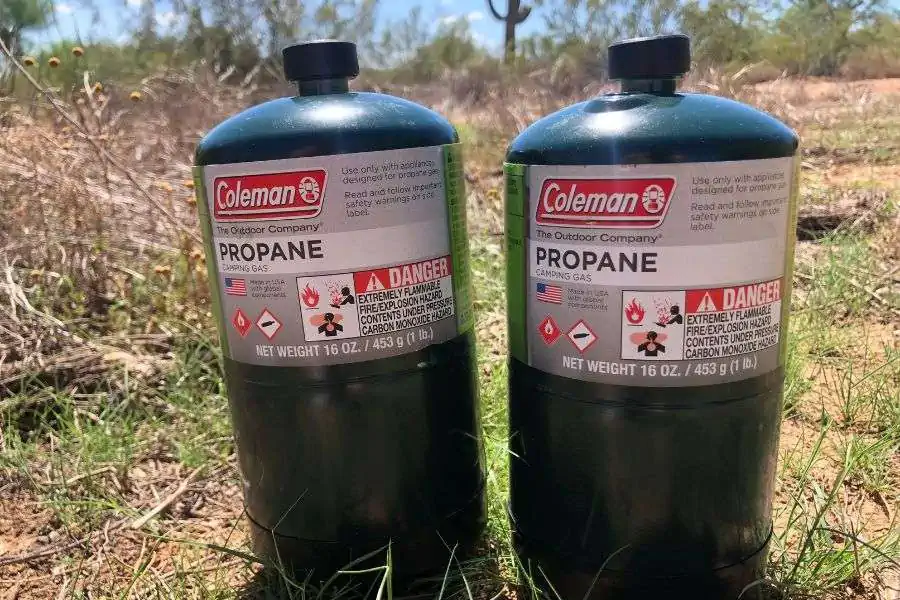
Like butane, propane is also colorless and odorless gas compressed and stored as a liquid.
Today, propane is used for everything from camping stoves to home heating systems and appliances.
Because it has such wide use, it’s no surprise you can find it virtually anywhere.
Whether it’s hardware, outdoor, retail store or a gas station, there’s a 99% chance you’re able to get it there.
Because of its universal use, propane is sold in different sizes, ranging from 16 ounces to as much as 1,000 gallons. Of course, the larger ones are designated for heating homes or powering multiple appliances.
For camping, you’ll be sticking with a canister between 1 and 5 pounds (1 pound propane canister pictured above). What’s great about propane canisters is that they’re refillable.
This means you don’t have to buy them every time you run out of fuel – so you’re both saving your money and the environment from unnecessary waste.
The fact that the smallest canister is 16 ounces is a bit of a drawback.
Since propane is stored at high pressure, it requires a tough canister to hold it in – usually made of stainless steel.
This means it’s a bit heavier, as well as bulkier, for a backpacking trip compared to some other fuel alternatives.
But that doesn’t mean propane doesn’t have its advantages over other types of fuel. The most important one is its ability to work well in adverse conditions.
Propane has a boiling point of -43.6° Fahrenheit. This means that, as long as the outdoor temperature is above that, your stove will work just fine.
For this reason, propane is superior when it comes to camping in cold conditions.
What’s more, propane also works well regardless of the altitude you’re at.
So if you’re camping in the mountains, this is your best fuel option.
Finally, nothing less important is the fact that propane is environmentally friendly. While it does emit a fairly low amount of carbon monoxide, it doesn’t emit any harmful substances such as sulfur dioxide or methane.
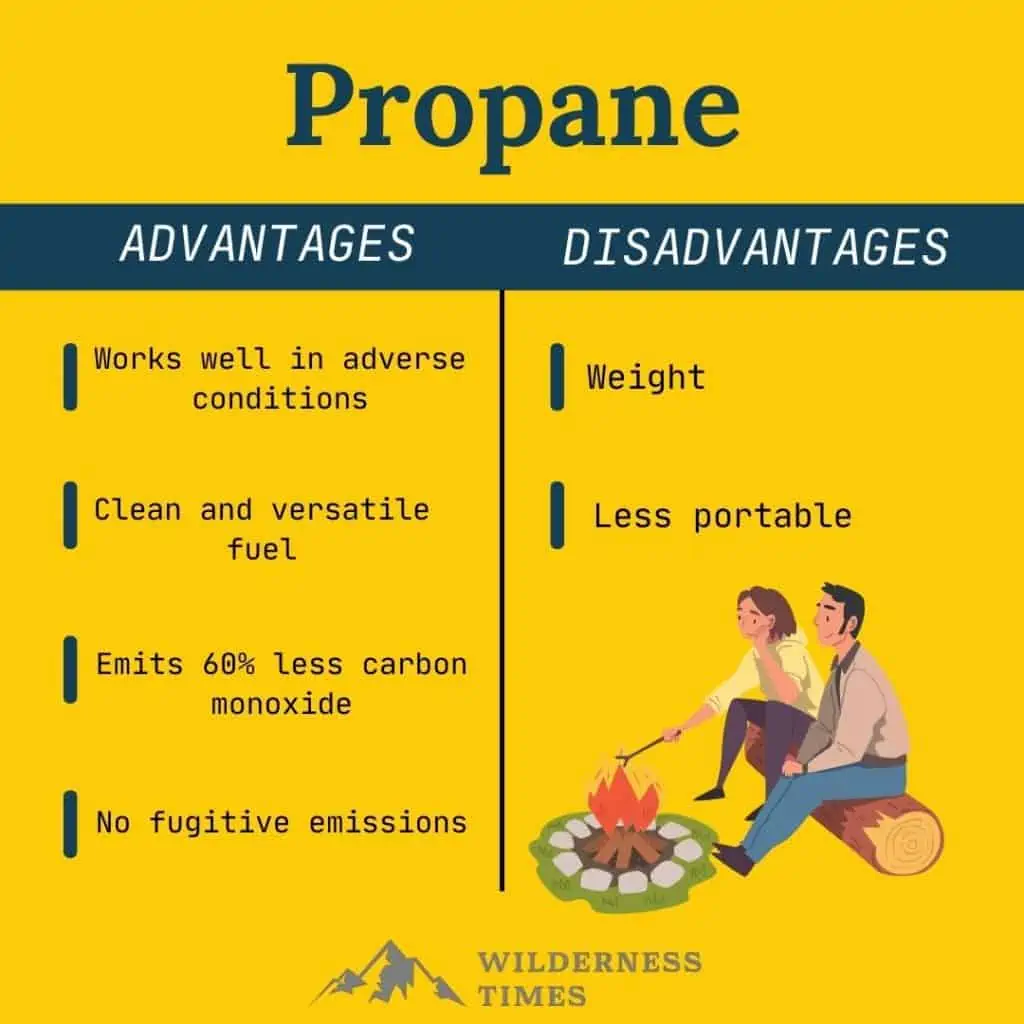
Advantages of Using Propane
- Works well in adverse conditions
- Clean and versatile fuel
- Emits 60% less carbon monoxide
- No fugitive emissions
- Canisters are refillable
Disadvantages of Using Propane
How to Use a Propane Stove
Using a propane stove is slightly different than using one powered with butane. But nonetheless, it’s nothing complicated. Here’s what you need to do
- Make sure the knob is in the “off” position before you start setting up the stove.
- Screw in the regulator until it’s hand-tight. In case you’re using a larger canister than a 16-ounce one, you’ll need a specially designed camping propane hose instead.
- Remove the plastic can from the head of the propane bottle, and screw it onto the regulator.
- You want the bottle to be tilted, with the head facing up.
- Grab a lighted match and hold it near the burner, while at the same time turning the knob on.
- Adjust the temperature as you need. You want to see the blue flames with a hint of yellow at the top.
- Once you’re done cooking, turn the knobs back to the “off” position.
- Unscrew and remove the canister from the stove.
Isobutane
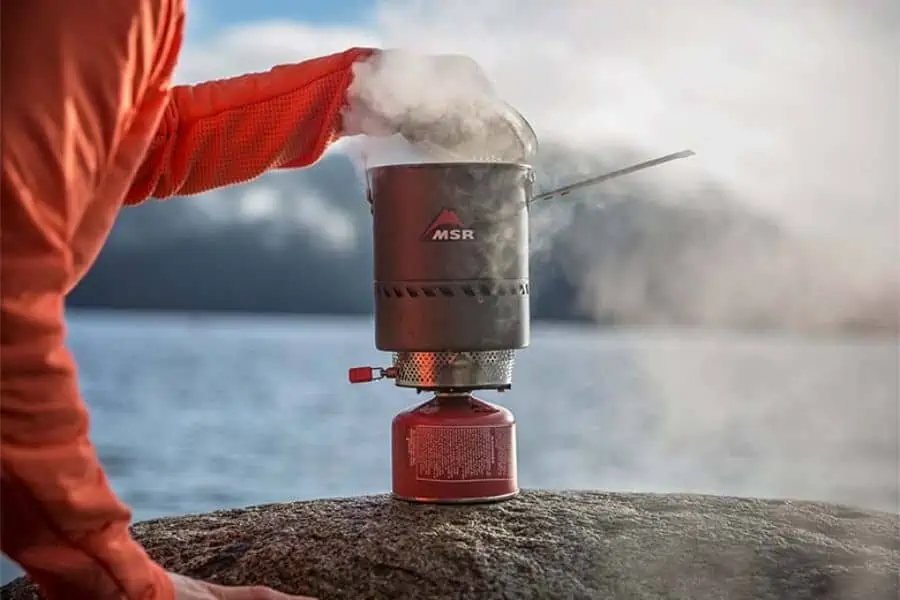
Isobutane, as the name suggests, is an isomer of butane. What this means is that both compounds have the same formula, but their molecules have different positions. And because of that, these two isomers behave slightly differently.
Namely, isobutane can work at temperatures as low as 14° Fahrenheit, which is much lower than its counterpart.
This makes isobutane a suitable choice for camping throughout most part of the year.
What’s also great about isobutane is that it has more energy packers into it by volume. This means you can cook longer with less fuel, when compared to the other two options.
Furthermore, isobutane is sold in canisters ranging between 4 and 8 ounces, which makes it suitable for backpacking and hiking.
You can find these canisters in most outdoor and big box stores.
You might also find it at certain gas stations, but that’s not as common.
Often, isobutane is mixed with propane to create a blend that has a bit of both.
These products burn well in cold temperatures but aren’t as heavy as classic propane canisters.
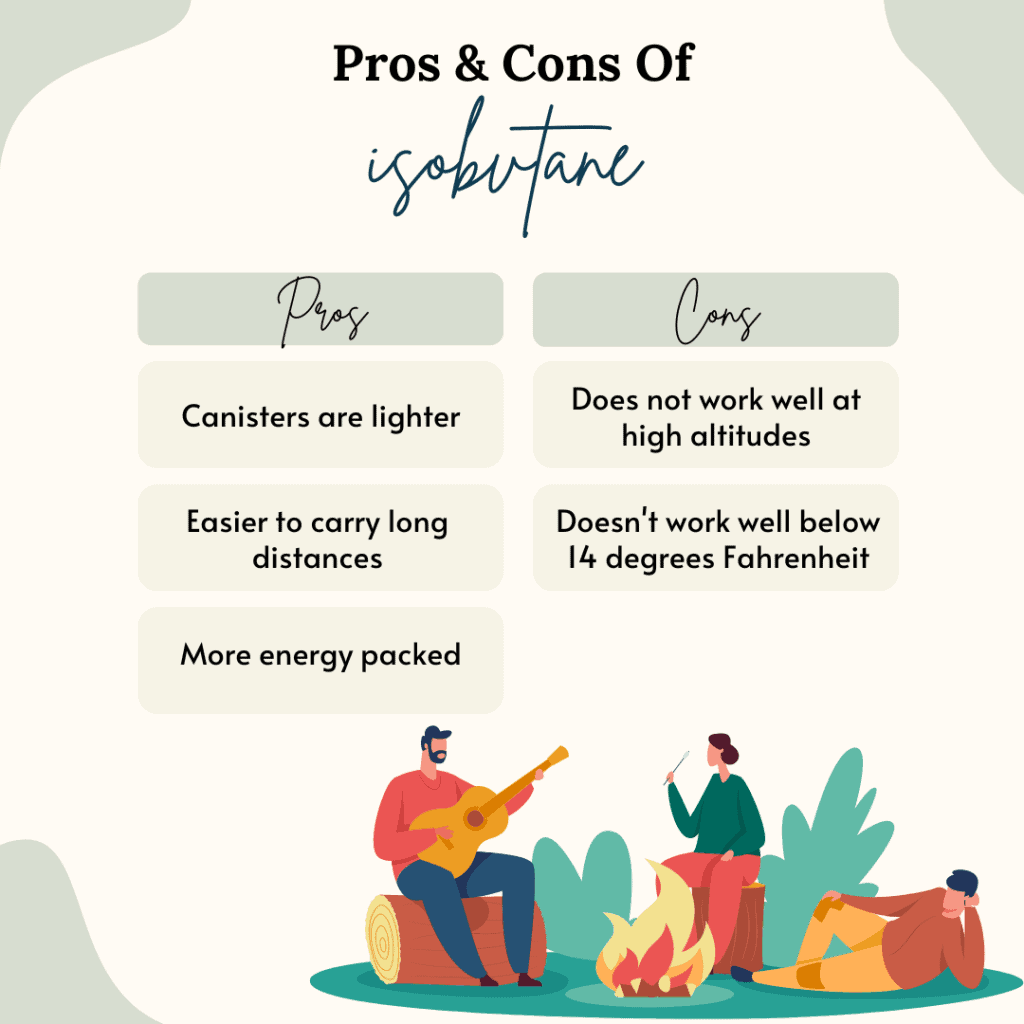
Advantages of Using Isobutane
- Canisters are lighter and smaller
- Easier to carry long distances
- More energy packed
Disadvantages of Using Isobutane
- Does not work well at high altitudes
- Doesn’t work well below 14 degrees Fahrenheit
- Have to buy a new container every time.
How to Use an Isobutane Camping Stove
An isobutane stove is arguably the easiest one to set up. After all, they’re mainly designed for backpacking and ultralight camping. Here’s how to use it:
- Spread out the pot support parts fully.
- Fold the flame control handle in place and position it to be completely closed.
- Screw the stove onto the isobutane canister. Screw it tight, but not overly, as it can wear out the stove ring.
- Turn the flame control counterclockwise a partial turn, then light the stove.
- Once done, turn the flame off.
- Let the stove cool down before disassembling it.
Butane vs. Propane
Let’s see how these two fuels compare in different categories:
As you can see Propane is the clear winner in almost everything but weight and safety. If weight is your concern and the weather is appropriate butane may be a better choice for you.
But in general Propane is more readily available and is better for the environment as it comes in refillable containers.
Butane vs Isobutane
Here’s a comparison of these two isomers:
Similar to the last comparison, isobutane beats out butane in so many factors. Not only is it cheaper, but it works to 14° Fahrenheit and is better equipped for most cold weather situations. Of course if weight is a factor than butane may be the better option and it is indeed less combustible.
Isobutane vs Propane
Finally, let’s see which one of these gases performs better in different categories:
In this case, there are again clear benefits to both. Isobutane is a great choice for those looking for a lightweight and smaller option and a bit safer gas.
On the other hand propane is going to work much better in extreme temperatures (down to -43.6° Fahrenheit), and it’s going to cost less too. Not only that, but its refillable containers are more sustainable.
How to Choose the Best Gas Stove for Camping
You’re probably wondering – which stove is better for camping? And to give you an answer, first we need to see how well they perform in different categories.
Fuel Availability
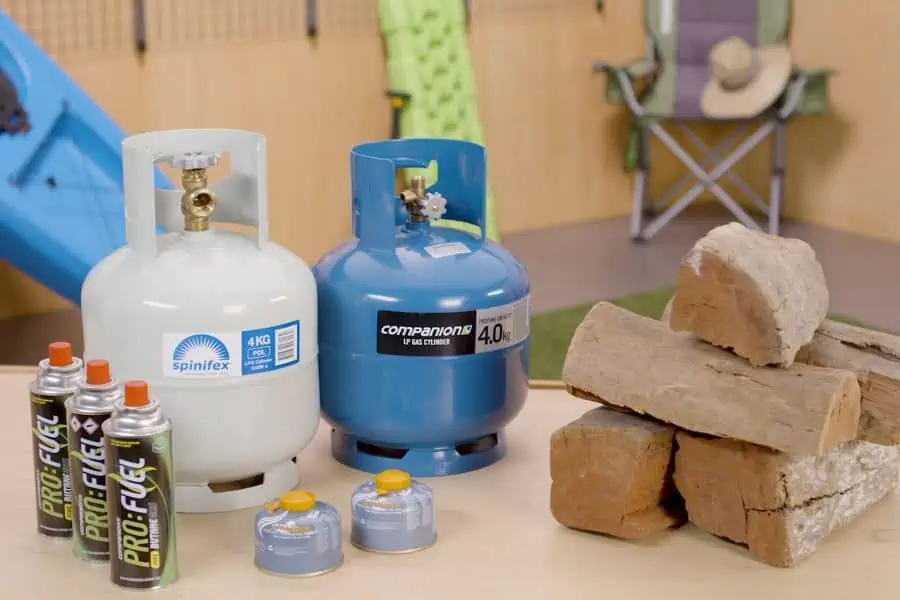
Since each of these fuels is used for camping, you’d expect to find them at outdoor gear stores, right?
Well, that’s not always the case.
Butane, for instance, is not that common to see on shelves in a local outdoor store.
Sure, you can find butane canisters in Walmart, but as far as more remote areas go, you’ll probably have more trouble finding them.
Propane, on the other hand, is widely available. Not just in outdoor and hardware stores, but you can also get it at gas stations.
After all, it’s commonly used not just for camping, but for home purposes as well.
Isobutane falls in the middle ground. You can find it at outdoor gear as well as big box stores, but the further you move from the city, the harder it gets to find it.
Stove Compatibility
Clearly, there’s really no point in owning a certain fuel canister if you can’t use it with your stove.
Now, there are a million different camping stoves on the market.
But even so, most of them work on one of the three fuel types we’re reviewing today.
A good majority of 2-burner stoves on the market run on propane.
And while for a short camping trip using a 16-ounce canister seems more practical, you can attach a propane tank of any size if you want.
Smaller, single burner stoves usually run on butane. However, this type of stove is not as common as it used to be.
Finally, backpacking stoves are mostly powered by either isobutane or isobutane-propane combo.
However, you can find certain models that work with more than one fuel source, although they are rare.
Fuel Cost
Nothing less important factor is the price of each fuel type.
And while the actual numbers vary from retailer to retailer and from place to place, we can get a rough estimate.
The first spot when it comes to fuel cost definitely goes to propane.
Not only is it cheaper per pound compared to the other two fuels, but you can also get it in much larger canisters.
Plus, since the canister is refillable, you only need to buy it once, compared to the other two.
Butane tends to be more affordable than isobutane, but since it’s not as widely available as other types of fuel, you might struggle to find it.
With isobutane, the price also depends on the size of the canister.
Usually, isobutane is sold in canisters ranging from 4 to 16 ounces. And the smaller you go, the pricier the ounce of this fuel is.
Burn Efficiency
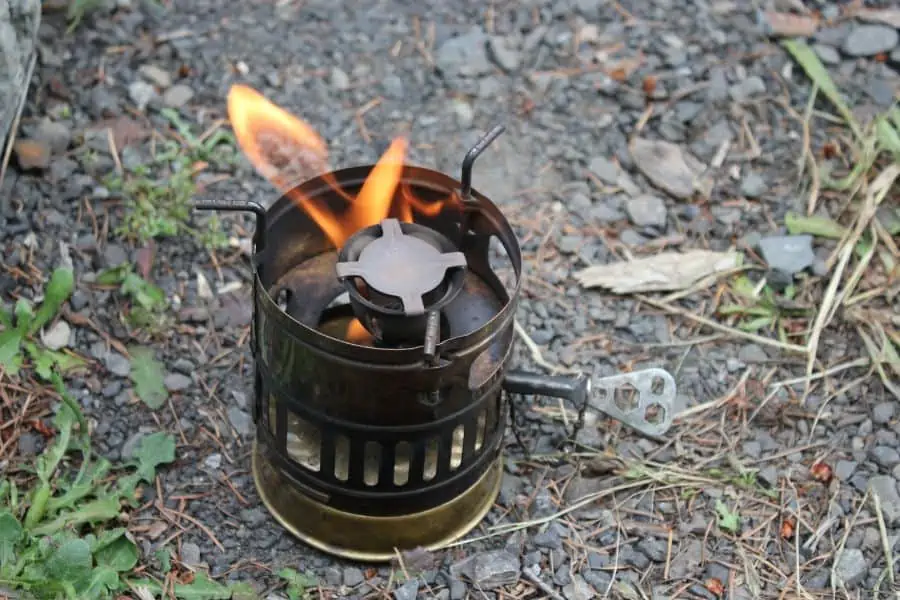
Burn efficiency is basically a measure of how well a certain type of fuel is transferred into heat.
And when these three types are compared, butane and isobutane have a slight win over propane.
But those numbers don’t actually mean a lot. Why?
Well, because we also have to take in other factors as well, such as the quality of your stove and outside temperature.
In reality, you’re not going to notice any real difference between the three when it comes to using a camping stove.
You simply won’t cook that much to make fuel type a big difference when it comes to burning efficiency.
Cold Weather Tolerance
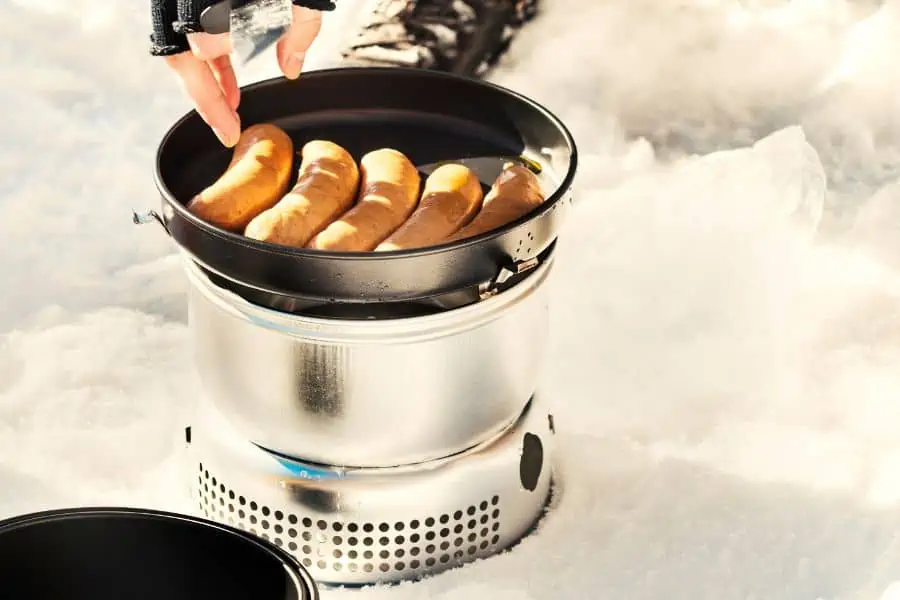
Each of these gases has a different flash point – the temperature at which liquid turns to gas.
So below those temperatures, these fuels turn into liquid, making it impossible to ignite a stove.
As long as you’re camping in a temperature that’s above -43.6° Fahrenheit, propane will keep your stove fueled.
In other words, you can practically use it anywhere aside from deeply into Antarctica.
With isobutane, the flash point is at 11° Fahrenheit. This makes it suitable for most camping trips.
Butane, however, only works when temperatures are above the freezing point.
For that reason, you should only pack it when you’re camping during warmer months.
Size and Storage
Butane usually comes in small canisters, ranging in size between 4 and 16 ounces.
They’re shaped like spray paint, which makes them easy to pack inside your backpack.
And since the canister is made of aluminum, there’s practically no added weight except for the actual fuel inside.
Similarly, isobutane is also sold in small canisters. But unlike butane, isobutane is more pressurized, so it requires a sturdier canister.
Typically, steel is used, but alloys are also common.
Propane is definitely the heaviest one to carry around, as its canisters are made of steel.
Furthermore, the smallest size available is 16 ounces, which can be heavy when you’re backpacking.
Read: What is Backpacking? The Ultimate Guide for Beginners
Safety Tips for Using a Camping Stove
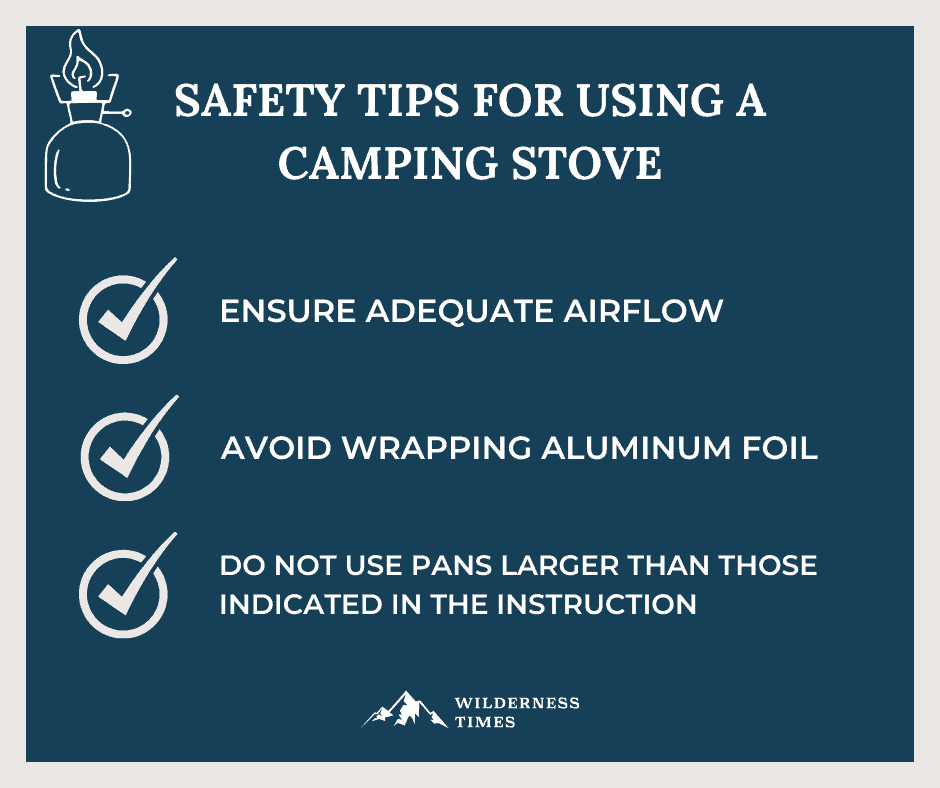
Like any other fuel, gas fuels pose certain risks when using them.
But, with a few things to keep an eye on, there’s no reason why you couldn’t use one safely.
Ensure Adequate Airflow
Since they’re fueled with liquid petroleum gases, camp stoves produce carbon monoxide while burning.
The problem with carbon monoxide is that it’s odorless, colorless, tasteless and, most importantly, dangerous if you inhale a lot of it.
Carbon monoxide doesn’t pose a serious threat outside, as it mixes with the oxygen in the air.
But when you’re in a more secluded space, there’s not enough airflow to allow the adequate mixture of these gases.
Too much carbon monoxide in the air is dangerous to our health. At first, it can cause dizziness and nausea, but ultimately, it can kill you.
Now, as long as you ensure there’s enough airflow, this isn’t something you should be worried about.
Avoid Wrapping Aluminum Foil
You might have seen people wrapping stove burners with aluminum foil.
This is usually done to make cleanup an easier task. But no matter how practical it might appear, refrain from doing that.
Aluminum foil gets combustible at temperatures above 1220° Fahrenheit. (source: Is Aluminum Foil Flammable?)
Well, your stove can reach that temperature with any of the three fuel types.
If the foil catches on fire, that’s dangerous not just because the flames can spread onto the surroundings.
It’s also dangerous because inhaling aluminum can get you sick as well.
Furthermore, melted aluminum can fuse with the burner, thus rendering your stove useless.
Use stove in a well-ventilated place
After Use, Remove the Gas Canister From the Stove
As soon as you’re done cooking, turn off the stove. Then, after it cools down after a few minutes, remove the gas canister as well.
It’s true that you lose a little bit of gas every time you attach and detach it, but it’s all done for safety reasons.
You can never be sure when your stove might malfunction. Whether you didn’t turn the knob all the way or something broke inside, anything can potentially cause a fuel leak.
But if you remove the canister from the stove, this is no longer something to worry about.
Do Not Use Pans Larger Than Those Indicated in the Instruction
While technically you can use a larger pot without damaging your stove, that’s not recommended.
Using a pot that’s larger than the burner means only the middle part of it will get warmed up.
This can easily get your food scorched. And not just that, but it will take much longer for your meal to cook.
FAQs
How is isobutane different from butane?
Isobutane and butane have the same chemical formula, as well as molar mass.
But their molecules are positioned differently, causing the two gases to behave differently.
Most importantly, isobutane has a lower flash point than butane, making it more suitable for colder weather.
Is isobutane toxic to humans?
Like any other liquid petroleum gas, isobutane emits carbon monoxide.
While in small quantities is harmless, too much of it can cause serious health issues.
In fact, without adequate airflow, carbon monoxide can build up enough to cause death.
Which is better: a butane or propane stove?
Neither of the two is ultimately better than the other.
The answer to this question depends on the camping conditions. If you’re going on a short backpacking trip during warmer months, a butane stove is a better option.
On the other hand, butane won’t work in cold temperatures. In that case, propane is suitable for such an environment.
Furthermore, propane is better for RV camping, since you have enough storage space for a larger canister.
How long do butane stoves last?
This depends on the size of the canister. An 8-ounce butane canister will burn for about 2 hours on high heat.
On simmer, it can last around 4 hours before you run out of gas.
To Sum Things Up
So there you have it, butane, propane and isobutane compared.
As you can see, there’s no clear winner in this battle.
Butane is easy to use, lightweight and compact, so it’s suitable for casual camping trips.
Propane is great for winter camping, as it works well even in extreme conditions. It’s also much better for high-altitude camping.
Isobutane has a bit of both. It’s light and compact, so it’s suitable for backpacking.
It works in relatively cool temperatures as well, so it’s suitable for most camping trips.
Ultimately, the best choice is the one that suits your camping conditions the most.

